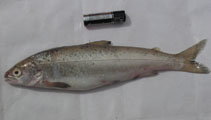| Family: |
Salmonidae (Salmonids), subfamily: Salmoninae |
| Max. size: |
33.6 cm SL (male/unsexed); max.weight: 685.0 g; max. reported age: 12 years |
| Environment: |
demersal; freshwater; depth range 40 - 60 m |
| Distribution: |
Europe: Lake Ohrid in Albania and Macedonia. |
| Diagnosis: |
Distinguished from all its congeners in Balkan Peninsula by the following unique characters: usually 54-55 vertebrae (56-63 in other species of Salmo); and teeth on vomer extending to posterior-most end of shaft. Additional characters, but not unique, useful for its identification include the following: 100-114 scales along lateral line; 11-12 scale rows between lateral line and adipose; 2 supraorbitals; snout blunt, its length about equal to eye diameter; body plain yellowish silvery or with a few small, x-shaped pinkish dots; 18-22 gill rakers; and 25-29 pyloric caeca (Ref. 59043). |
| Biology: |
Occurs in lakes, from surface to about 20 m depth in summer and near shores in winter. Forms schools (Ref. 59043). Feeds on benthic invertebrates, zooplankton and fish larvae. Spawns in December-February. After spawning, it leaves the coastal areas and stays in deep water. Caught mainly in winter at depths of 25-50 m. Highly valued and usually consumed fresh (Ref. 12290). Threatened due to overfishing and the introduction of other species (Ref. 26100) and intentional hybridization that has been going for 50 years (Ref. 59043). |
| IUCN Red List Status: |
Vulnerable (VU); Date assessed: 31 January 2006 (D2) Ref. (130435)
|
| Threat to humans: |
harmless |
| Country info: |
|
Source and more info: www.fishbase.org. For personal, classroom, and other internal use only. Not for publication.

